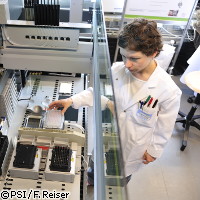Protein complexes production made easy
Proteins are the building blocks of life. They also play the starring role in many cellular processes. However, those complicated processes for the most part are directed by a number of proteins interacting within protein complexes. A new method for multiprotein complex production, developed by scientists funded in part by the EU, might now help facilitate the study of these important but elusive complexes. The new method could open up avenues for the discovery of drug targets, making it the focus of interest for the pharmaceutical industry. In a paper published in the journal Nature Methods, scientists from the European Molecular Biology Laboratory (EMBL) and their colleagues in France, Switzerland, Sweden and the UK describe 'the first fully automated pipeline for the production of multiprotein complexes', dubbed ACEMBL. 'Functional and structural studies that aim to decipher the physiologically relevant molecular mechanisms of these [multiprotein] complexes are becoming increasingly important in biology,' the team of researchers explain. Yet, cells frequently do not carry enough of them for meaningful analysis. Furthermore, they add, the 'frequently heterogeneous nature of many multisubunit complexes [...] often precludes their extraction from a native source.' In order to bypass these obstacles, biologists tend to resort to recombinant production methods, in which bacteria - most commonly the intestinal bacterium Escherichia coli (E. Coli) - are manipulated into producing the required proteins by introducing recombinant DNA into them (recombinant DNA does not exist naturally, it is made by combining DNA sequences). However, the method is complicated and time consuming. It also limits the complexity of the proteins that can be produced and makes them difficult to adapt; adaptability is essential in cases where an experiment needs revision. The new ACEMBL method, on the other hand, uses recombineering (recombinogenic engineering) instead of conventional genetic engineering, which requires additional intermediate steps and a well defined section of the DNA strand to be replaced. The ACEMBL system can produce complexes with a variety of components such as proteins and ribonucleic acid (RNA), for example. 'Arrays of genes, encoding subunits of a particular multiprotein complex, and potentially also accessory proteins (a protein that accompanies and assists another protein, which has a primary function) [...] can be assembled, disassembled and exchanged using the ACEMBL system,' the researchers say. 'This offers intriguing avenues for combinatorial analyses of protein-protein interactions or of interactions between protein complexes and modifiers.' Currently, the fully automated ACEMBL system - like traditional systems - works on the basis of E. coli bacteria. 'E. coli still remains the dominant workhorse in most laboratories, for many good reasons such as low cost and the availability of many specialised expression strains,' the study reads. In the future, the researchers hope to adapt it for production in more complex cells, and in the more complex systems at work in the human body. The work was partly funded by EU projects, including the Sixth Framework Programme's SPINE2C ('From receptor to gene: structures of complexes from signalling pathways linking immunology, neurobiology and cancer') and 3D-Repertoire ('A multidisciplinary approach to determine the structures of protein complexes in a model organism') projects. It also received support from the European Infrastructures for Structural Biology (INSTRUCT) and through Protein Production Platforms (PCUBE), which are both supported by the Seventh Framework Programme (FP7).
Countries
Switzerland, France, Sweden, United Kingdom



